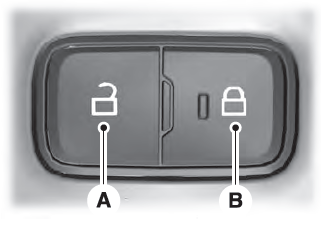Lincoln Aviator: Supplemental Restraint System / Removal and Installation - Front Impact Severity Sensor
Removal
.jpg) WARNING:
The following procedure prescribes critical repair steps
required for correct restraint system operation during a crash. Follow
all notes and steps carefully. Failure to follow step instructions may
result in incorrect operation of the restraint system and increases the
risk of serious personal injury or death in a crash.
WARNING:
The following procedure prescribes critical repair steps
required for correct restraint system operation during a crash. Follow
all notes and steps carefully. Failure to follow step instructions may
result in incorrect operation of the restraint system and increases the
risk of serious personal injury or death in a crash.
NOTE: Removal steps in this procedure may contain installation details.
-
Refer to: Pyrotechnic Device Health and Safety Precautions (100-00 General Information, Description and Operation)..jpg) WARNING:
Before beginning any service procedure in this
manual, refer to health and safety warnings in section 100-00 General
Information. Failure to follow this instruction may result in serious
personal injury.
WARNING:
Before beginning any service procedure in this
manual, refer to health and safety warnings in section 100-00 General
Information. Failure to follow this instruction may result in serious
personal injury.
-
Depower the SRS.
Refer to: Supplemental Restraint System (SRS) Depowering (501-20B Supplemental Restraint System, General Procedures).
-
On both sides.
Remove the headlamps.
Refer to: Headlamp Assembly (417-01 Exterior Lighting, Removal and Installation).
-
Remove the screws and the radiator core support bracket.
.jpg) |
-
Remove the front impact severity sensor(s).
-
Disconnect the electrical connector(s).
-
Remove the bolt(s).
Torque: 106 lb.in (12.0 Nm)
-
Remove the front impact severity sensor(s).
-
Disconnect the electrical connector(s).
.jpg) |
Installation
-
NOTE: The front impact severity sensor mating surfaces must be smooth and allow for a flush attachment to each other.
To install, reverse the removal procedure.
-
Repower the SRS.
Refer to: Supplemental Restraint System (SRS) Repowering (501-20B Supplemental Restraint System, General Procedures).
 Removal and Installation - Front Door Side Impact Sensor
Removal and Installation - Front Door Side Impact Sensor
Removal
WARNING:
The following procedure prescribes critical repair steps
required for correct restraint system operation during a crash. Follow
all notes and steps carefully...
 Removal and Installation - Occupant Classification System (OCS) Sensor - Vehicles With: Multi-Contour Seats
Removal and Installation - Occupant Classification System (OCS) Sensor - Vehicles With: Multi-Contour Seats
Special Tool(s) /
General Equipment
Flat Headed Screw Driver
Removal
WARNING:
The following procedure prescribes critical repair steps
required for correct restraint system operation during a crash...
Other information:
Lincoln Aviator 2020-2025 Owners Manual: Drive Modes
Conserve Enables efficient driving. It helps to deliver maximum fuel efficiency and helps to increase driving range. Deep Conditions (If Equipped) For crossing terrain that has deformable deep, rutted surfaces such as mud, deep sand or deep snow. Do not use on dry, hard surfaced roads...
Lincoln Aviator 2020-2025 Service Manual: Description and Operation - Universal Transmitter - System Operation and Component Description
System Operation Universal Transmitter The universal transmitter learns a hand-held transmitter radio frequency code and stores the code in memory. It consists of 3 buttons with an indicator lamp. Once the universal transmitter code is stored, the universal transmitter emits the radio frequency of the hand-held transmitter when the corresponding button is pressed...
Categories
- Manuals Home
- Lincoln Aviator Owners Manual
- Lincoln Aviator Service Manual
- Locking and Unlocking
- Remove and Reinstall the Battery
- Opening and Closing the Hood
- New on site
- Most important about car
Locking and Unlocking the Doors from Inside

Locking the Doors
Press the lock switch on the door interior trim panel. The doors can no longer be released using the exterior door handle switches and the luggage compartment locks.
